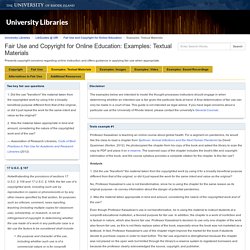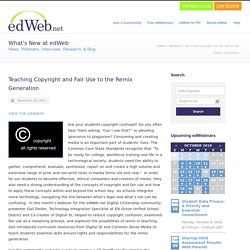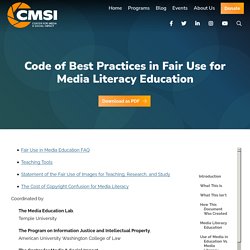

(668) Fair Use in Seven Words. Fair use myths and facts infographic feb2017. Examples: Textual Materials - Fair Use and Copyright for Online Education - LibGuides @ URI at University of Rhode Island. Professor Hallberg-Smith teaches a hybrid course in econometrics.

Instead of using an expensive textbook, she posts course content in Brightspace that she herself wrote. During class sessions students work in groups to solve and review problem sets, and she takes questions about the readings and the problems. Hallberg-Smith has not had time to create her own problem sets for the course; instead she uses problems from the textbook Introduction to Econometrics written by James H. Stock. Copyright Primer. Overview Faculty members have often used copyrighted materials in the classroom.

Armed by the idea of "Fair Use" they copied and distributed pages of books, news articles, and photographs to use as part of the teaching process. But the days of mimeographs and video copies are gone, replaced by the digital domain where the copy is as good as the original. So, now, copyright is a very real, very serious concern. As new media has changed our process of making copies, so the online world has changed our understanding of distribution of copyrighted materials.
TEACH Act Scenarios. Scenario 1 KCPT is a public television station in Kansas City, Missouri, which offers distance learning programs.

The station has a written copyright policy and televises programs regarding U.S. copyright law to educate its viewers. In addition to using 4-way full-motion video to broadcast class sessions, the station also uses Blackboard to distribute course content to students enrolled in online classes. A statement appears on the online course's home page regarding the presence of copyrighted materials on the Web site. The station restricts the transmission of copyrighted materials to students officially enrolled in a course, according to TEACH Act institutional requirements. Best Practices in Fair Use for Open Educational Resources - American University Washington College of Law. We are pleased to announce the release of the Code of Best Practices in Fair Use for Open Educational Resources.

This document is intended to support authors, teachers, professors, librarians, and all open educators in evaluating when and how they can incorporate third party copyright materials into Open Educational Resources to meet their pedagogical goals. REPORT: Code of Best Practices in Fair Use for Open Educational Resources Webinar: Wednesday, February 17, 2021 | 3:00pm-4:30pm ET (12 pm PT) Registration: This Best Practices is built on a series of workshops, interviews, and webinars that were conducted over the course of 2019 and 2020. Without the contributions of those partners and participants this project would not have been possible, and we want to recognize their indispensable support for this project.
Copyright & Creativity : K-12 Teaching Resources on Copyright and Fair Use. The unified voice of the copyright community. Copyright Basics: Northern State University. WEB COURSE: Copyright for Educators. WEBINAR: Teaching Copyright and Fair Use to the Remix Generation. Are your students copyright confused?

Do you often hear them asking, “Can I use that?” Or pleading ignorance to plagiarism? Consuming and creating media is an important part of students’ lives. The Common Core State Standards recognize that “To be ready for college, workforce training and life in a technological society, students need the ability to gather, comprehend, evaluate, synthesize, report on and create a high volume and extensive range of print and non-print texts in media forms old and new.” VIDEO Creativity, Copyright & Fair Use (Common Sense Media) ALA: Copyright Tools. Copyright tools can help libraries and others to be more comfortable with their work to interpret the limitations and exceptions to the exclusive rights granted to the copyright holder under U.S.

Copyright law. By exercising these valuable exceptions, we strengthen copyright’s primary purpose "to promote the progress of science and useful arts. " Over the past several years, ALA has developed tools to educate libraries, librarians, and others about copyright. Copyright Crash Course: University of Texas. The Copyright Crash Course was created by Georgia Harper and is currently maintained by UT Libraries.

The Course is arranged into several sections that allow users to explore certain areas of copyright law individually or as a group. The Course was originally created with faculty in mind, but can be used by anyone who is interested in understanding and managing their copyrights. If you need to take the Crash Course tutorial & test, click here (UT affiliation required). Version 1 of the Copyright Crash Course is available via Texas ScholarWorks. You are using Version 2. The Educator's Guide to Creativity & Copyright. Applied Copyright: Find & Use Free Media. Fair Use Evaluator. Measuring Fair Use: The Four Factors.
Unfortunately, the only way to get a definitive answer on whether a particular use is a fair use is to have it resolved in federal court. Judges use four factors to resolve fair use disputes, as discussed in detail below. It’s important to understand that these factors are only guidelines that courts are free to adapt to particular situations on a case‑by‑case basis.
In other words, a judge has a great deal of freedom when making a fair use determination, so the outcome in any given case can be hard to predict. The four factors judges consider are: the purpose and character of your usethe nature of the copyrighted workthe amount and substantiality of the portion taken, andthe effect of the use upon the potential market. Ignore Heading – Sub heading content Ignore Heading – Sub table content. Copyright Basics (from SDSL) Code of Best Practices in Fair Use for Media Literacy Education - Center for Media and Social Impact. Coordinated by: The Media Education Lab, Temple University The Program on Information Justice and Intellectual Property, American University Washington College of Law The Center for Media & Social Impact, American University With funding from: The John D. and Catherine T.

Preventing collisions at the intersection of creativity and copyright. Creative Commons. Attribution: Best Practices. You can use CC-licensed materials as long as you follow the license conditions. One condition of all CC licenses is attribution. Here are some good (and not so good) examples of attribution. Note: If you want to learn how to mark your own material with a CC license go here.
Examples of attribution Here is a photo. This is an ideal attribution Because: Title? Author? Source? License? This is a pretty good attribution. Creative Commons Kiwi. Videos from Creative Commons. One of the best ways to learn about Creative Commons is to watch one of our videos. What is Creative Commons? From our friends at Wikimedia, a short video describing Creative Commons licenses. Six Creative Commons Licences Overview (poster) Copyright and Creative Commons Explained (poster) Noun Project - Icons for Everything.
Flickr: The Commons. Unsplash. Foter. Photos For Class - The quick and safe way to find and cite images for class! Pics4Learning.